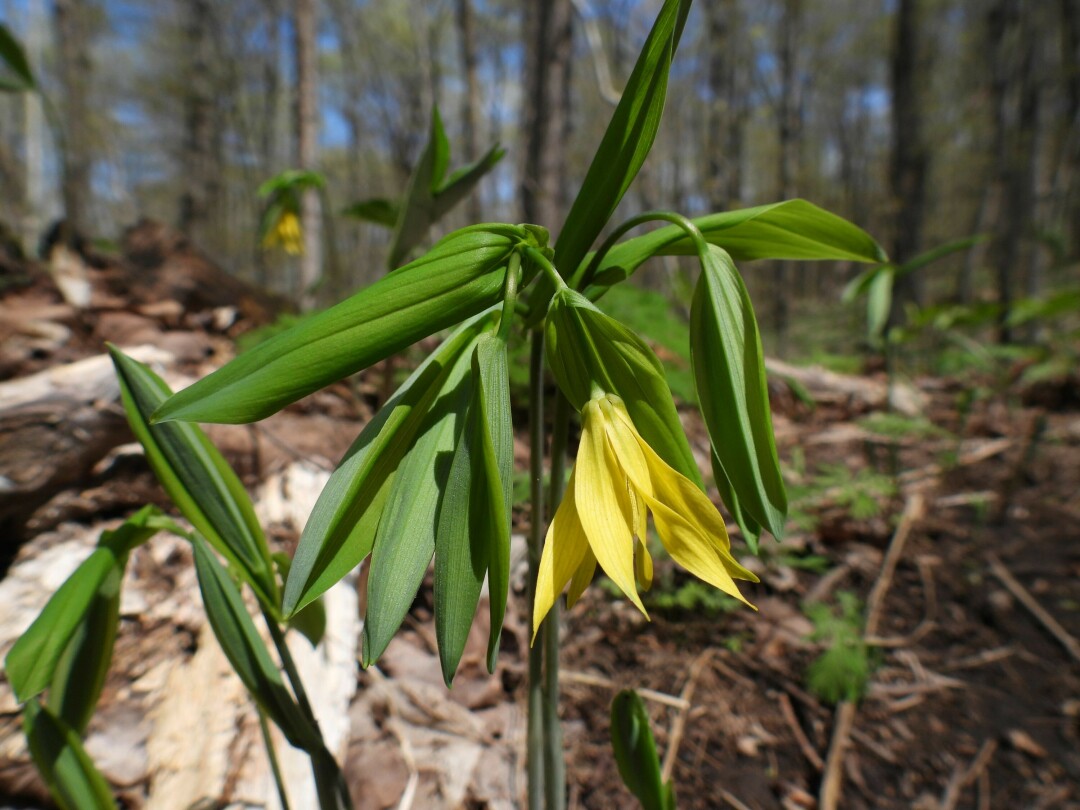News & Articles
Browse all content by date.

In just two days, large-flowered bellwort blooms went from being a rarity to an abundant flower on the forest floor. Photo by Emily Stone.
Cheerful sunshine illuminated the tiny, just-hatched leaves of maple trees. Their pinks and greens complimented the blue sky perfectly. A few black flies hovered nearby, but none seemed to be biting. No mosquitoes buzzed. Instead, black-throated green warblers trilled from the treetops. The delicate, pink-striped flowers of spring beauty carpeted the hillsides. Spring beauty, indeed!
This was the day I look forward to each spring – the birds were back, the flowers were blooming, and the bugs hadn’t become biting hordes.
My first saunter of the season along the trail to St. Peter’s Dome was a bit of a quiz game, though. While marsh marigolds, spring beauty, and bloodroots were in full bloom, many of the little plants were still tightly furled. I tried to guess their species by the shades of blue or purple in their leaves, or the little dab of red at a leaf node. The leaves of the large-flowered bellwort were big enough to identify, so then the challenge was to see a flower.
And after I spotted one bell-shaped bloom of canary yellow petals, I strained to spot three more on the sunny hillside. By the time I’d made the 4-mile trip to the overlook and back, I swear that the tree leaves had gotten bigger. Spring moves quickly once she gets going, so when I returned two days later to lead the Professor Hike, I wasn’t surprised to see big changes. Single blooms had turned into petal parties!
Professor Wild Oats was the first station. This pale, delicate cousin to the large-flowered bellwort looked to someone like the drooping, straw-colored seedhead of oats. With his duct-tape-nametag displayed proudly, Kevin taught each of the other participants in turn about this lovely little flower. Later, as we hiked along the trail, he spotted more wild oats than I’ve ever noticed in these woods! That heightened awareness is one benefit of the Professor Hike activity.
Professor Serviceberry was next. Two days prior, I’d found one serviceberry shrub with their white petals drooping gracefully at the top of the hill. On this day, the forest edges were frosted with their flowers. All the names of this plant refer to their phenology – the timing of their seasonal events. Serviceberry blooms when the ground has thawed enough so funeral services can be held for unfortunate souls who died over the winter when the ground was too hard to dig.
A little farther south, their tasty purple fruits ripen in June, hence the name Juneberry. Up here, we should call them July-berry instead. Shadbush is another name for serviceberry on the East Coast, where fish called shad swim from the ocean into the streams to lay their eggs about the time that these pretty white flowers are engaged in their own reproductive rituals.
The early and prolific flowers of serviceberries are an important food source for early-arriving bees, butterflies and hummingbirds. The flowers themselves benefit from this schedule because there is less competition for pollinators, and their blossoms may be easier to find in a leafless forest. This results in better pollination and more viable seeds.
The speed of spring can be dizzying, but it is no accident. Trees are racing to leaf out and take advantage of the intersection of bright sun and plentiful soil moisture. Flowers, like wild oats, are racing against the leaves. Known as spring ephemerals, they can benefit from the rich soil in shady depths of deciduous forests, so long as they get a head start on the trees. Flowers bloom, leaves unfurl, bees hum, ants crawl, seeds are set, photosynthesis produces sugars, and then—just as the tree leaves above are reaching their full potential and shade—the ephemeral leaves melt back into the duff.
All summer, fall, and winter, the sugars that the spring ephemerals raced to produce are stored as carbohydrates (complex sugars) in starchy roots. Burrow your finger into the soft soil near any of these plants, and you will soon pull out a small white tuber or thickened rhizome. This stored energy allows spring ephemerals to get a head start on the tree leaves each spring, and then rush to replenish their pantry for next year.
After Professors Flower Symmetry, Marsh Marigold, Cherry and Black Ash had taught each of their peers, we continued up the trail to find carpets of spring beauty, bellwort, Dutchman’s breeches, cut-leaved toothwort, trilliums, and wild ginger. At the top, we gazed across the tops of trees, their leaves practically growing as we watched. Even though I wish my beloved spring ephemerals could last longer, each spring I also cheer them on in their race against leaf-out. In many ways, the speed of spring is what makes it such an amazing season!
Emily’s award-winning second book, Natural Connections: Dreaming of an Elfin Skimmer, is available to purchase at www.cablemuseum.org/books and at your local independent bookstore, too. For more than 50 years, the Cable Natural History Museum has served to connect you to the Northwoods. The Museum is open with our brand-new exhibit: “Anaamaagon: Under the Snow.” Our Summer Calendar of Events is open for registration! Follow us on Facebook, Instagram, YouTube, and cablemuseum.org to see what we are up to.
| Tweet |


